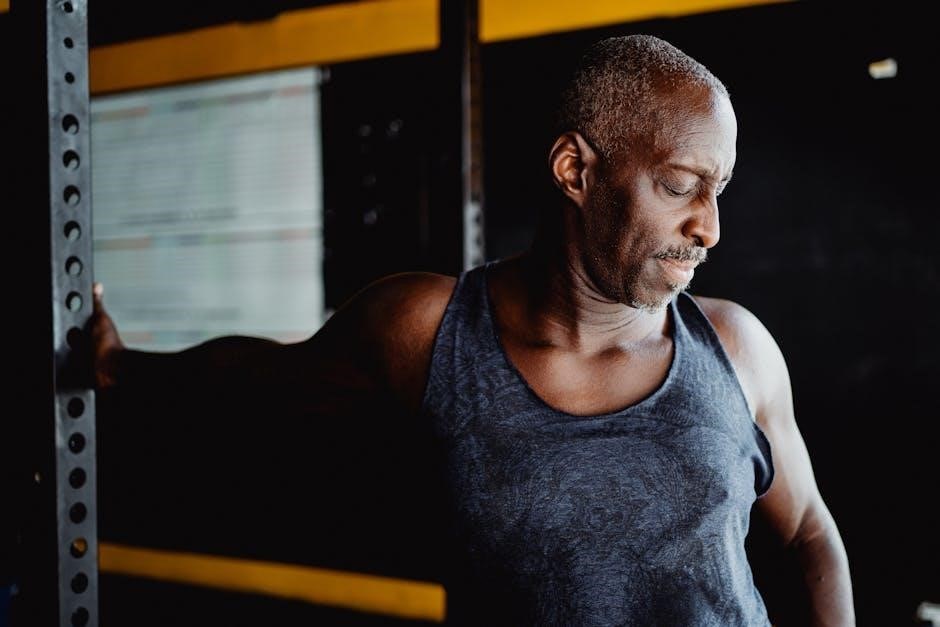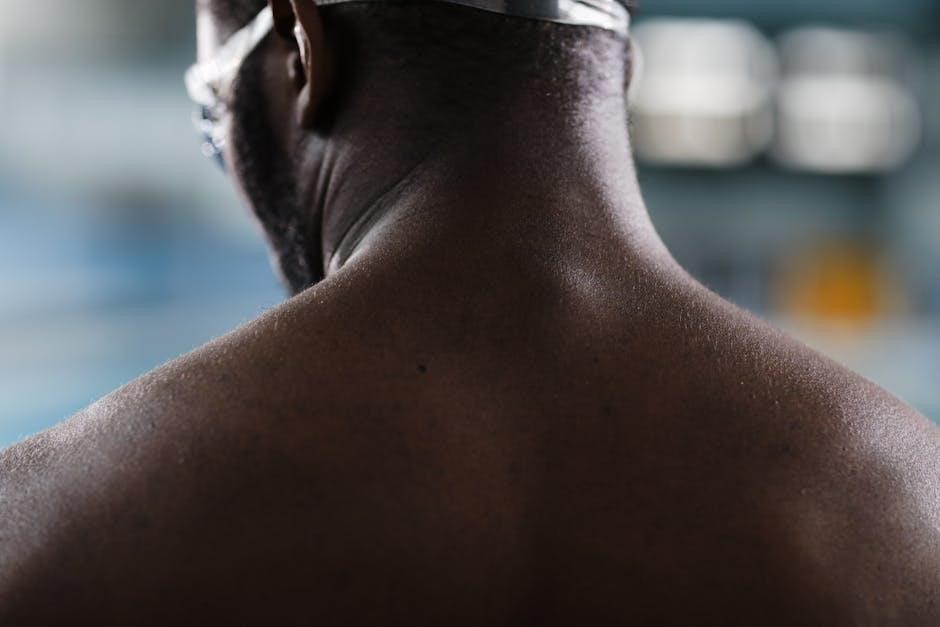
Dislocated shoulder exercises are crucial for restoring strength, mobility, and stability after an injury. This structured program includes phases from gentle movements to advanced strengthening, ensuring a safe recovery.
Understanding Shoulder Dislocation and Recovery
A shoulder dislocation occurs when the humerus bone is displaced from the glenoid socket, often due to trauma or falls. It is the most common large joint dislocation, frequently affecting young males. Symptoms include severe pain, limited mobility, and a visible deformity. Immediate treatment involves relocation of the joint, immobilization, and pain management. Recovery progresses through phases, starting with pain-free movements, followed by strengthening exercises, and concluding with advanced rehabilitation to restore full function and prevent recurrence. Proper rehabilitation is essential to regain strength, stability, and range of motion, ensuring the shoulder returns to optimal functionality and reducing the risk of future dislocations;
Importance of Exercise in Shoulder Rehabilitation

Exercise plays a vital role in shoulder rehabilitation by enhancing strength, stability, and mobility. It helps restore function to the muscles, ligaments, and joint capsule, reducing the risk of recurring dislocations. Early exercises focus on pain-free movements, progressing to strengthening and dynamic stabilization. These exercises improve joint stability, promote healing, and prevent atrophy. Consistent practice ensures a faster recovery, enabling patients to return to daily activities and sports safely. A structured exercise plan, tailored to individual progress, is essential for achieving optimal outcomes and preventing long-term complications.
Overview of the Exercise Plan

The exercise plan for a dislocated shoulder is structured into three phases, ensuring a gradual and safe recovery. Phase 1 focuses on pain-free active range of motion, isometric exercises, and hand, wrist, and elbow movements to maintain mobility. Phase 2 introduces strengthening exercises, such as static shoulder stabilization and resistance bands, to build muscle strength. Phase 3 advances to scapulo-thoracic exercises and active-assisted movements, preparing the shoulder for full functionality. Each phase includes specific exercises tailored to the patient’s progress, ensuring minimal strain and maximal recovery. Consistency and adherence to the plan, guided by a healthcare professional, are key to achieving optimal results and preventing future dislocations.

Phase 1: Immediate Post-Injury Exercises
Phase 1 focuses on pain-free active range of motion, isometric exercises, and hand, wrist, and elbow movements to maintain mobility while wearing a sling, 4-5 times daily.
Pain-Free Active Range of Motion Exercises
These exercises are essential in the initial recovery phase to maintain shoulder mobility without causing pain. Start with gentle movements, focusing on internal and external rotations, abduction, and flexion. Perform exercises while wearing a sling to avoid strain. Begin with 10 repetitions of each exercise, 4-5 times daily, and gradually increase as comfort allows. Internal rotation involves placing the affected arm across the abdomen, while external rotation uses a door frame for resistance. Abduction and flexion can be performed by lifting the arm sideways or forward, using the good arm for support if needed. These movements help prevent stiffness and promote healing. Progress slowly to avoid discomfort or recurrence of injury.
Hand, Wrist, and Elbow Exercises
Hand, wrist, and elbow exercises are vital during the initial recovery phase to maintain mobility and prevent stiffness. These exercises should be performed while wearing a sling to avoid straining the shoulder. Start with simple movements: open and close your hand, squeezing for 3 seconds, then relax. Repeat 10 times. Wrist exercises include moving your wrist up and down and side to side. For the elbow, perform bending and straightening motions while keeping the arm at your side. These exercises should be done 4-5 times daily, with 10 repetitions each. As mobility improves, gradually increase repetitions. Stop once full movement is achieved and exercises become easy. Always consult your healthcare provider before starting any new program.

Isometric Shoulder Exercises
Isometric shoulder exercises are essential for strengthening the shoulder muscles without moving the joint, reducing strain on the injured area. These exercises are performed while wearing a sling to protect the shoulder. Start with isometric shoulder external rotation: stand in a doorway with your elbow bent at 90 degrees, press your hand outward into the door frame, and hold for 5 seconds. Repeat 3 sets of 10 repetitions. Another exercise is isometric shoulder flexion: hold your arm at your side, engage your shoulder muscles, and hold for 5 seconds. Repeat 3 sets of 10. These exercises help improve strength and stability without risking further injury.

Phase 2: Strengthening Exercises
This phase focuses on gradually increasing shoulder strength and stability through static exercises, dynamic stabilization, and resistance bands, ensuring a safe progression from initial recovery.
Static Shoulder Strengthening Exercises
Static shoulder exercises focus on engaging the shoulder muscles without moving the joint. These exercises, such as shoulder flexion and external rotation, help improve strength and stability.
Dynamic Stabilization Exercises
Dynamic stabilization exercises aim to enhance shoulder joint control and muscle endurance during movement. These exercises, such as shoulder external rotation and scaption, involve gradual arm movements while maintaining proper joint alignment. They are performed with minimal resistance initially and progressed as strength improves. For example, standing in a doorway with the arm at 90 degrees, gently pressing outward against resistance. These exercises improve proprioception and dynamic stability, essential for preventing recurrent dislocations. Patients are advised to start with 3 sets of 10-15 repetitions, increasing as tolerated. Proper form and pain-free execution are critical to ensure effective rehabilitation and avoid further injury. These exercises are typically introduced after initial strength is restored in Phase 2 of recovery.
Progression to Resistance Bands
Progression to resistance bands is a key step in strengthening the shoulder muscles after a dislocation. Resistance bands provide controlled tension, helping to build strength and endurance. Start with light resistance and gradually increase as tolerance improves. Exercises include shoulder flexion, external rotation, and scaption, performed with the band anchored at waist height. Aim for 10-12 repetitions per set, completing 2-3 sets daily. Maintain proper form and avoid pain during movements. Resistance bands are versatile and portable, making them ideal for continued rehabilitation at home or during travel. This phase follows isometric exercises and prepares the shoulder for more dynamic movements, ensuring a balanced recovery and reducing the risk of future dislocations.

Phase 3: Advanced Rehabilitation
Phase 3 focuses on restoring full shoulder mobility and strength through dynamic exercises like scapulo-thoracic movements and resisted shoulder flexion, ensuring functional recovery and injury prevention.
Scapulo-Thoracic Exercises
Scapulo-thoracic exercises are essential for restoring proper shoulder mechanics and preventing future dislocations. These exercises target the muscles between the shoulder blade and chest wall, improving stability and range of motion. Techniques include wall slides, scapular squeezes, and manual resistance exercises. Start with gentle movements, ensuring pain-free execution. Progress to more dynamic exercises as strength and control improve. Perform these exercises 2-3 times daily, focusing on slow, controlled movements. Incorporate resistance bands or manual resistance for added challenge. Proper form is critical to avoid strain and maximize benefits. Over time, these exercises enhance shoulder blade positioning, reducing the risk of recurring instability and promoting a full return to activity. Consistency is key for optimal recovery and long-term shoulder health.
Active Assisted Shoulder Flexion

Active assisted shoulder flexion is a key exercise in advanced rehabilitation, helping restore mobility and strength. Stand or sit with your unaffected arm assisting the injured shoulder. Gently lift the injured arm forward, using your good arm for support, until pain-free range is reached. Slowly lower the arm over 8-10 seconds. Perform 10 repetitions, 2-3 sets daily. Progress by increasing elevation as comfort allows. This exercise enhances active range of motion and reduces reliance on compensatory movements. Proper form ensures the shoulder joint moves smoothly without strain. Over time, it improves flexion strength and control, preparing the shoulder for more dynamic activities. Consistency and gradual progression are vital for effective recovery and preventing future instability.
Resisted Shoulder Flexion

Resisted shoulder flexion targets the anterior deltoid and shoulder flexors, enhancing strength and stability. Anchor a resistance band at hip height or tie it securely. Hold the band with the injured arm, keeping the elbow straight. Slowly lift the arm forward, maintaining control, until reaching a pain-free range; Lower the arm gradually over 8-10 seconds. Perform 10 repetitions for 2-3 sets daily. Progress resistance as strength improves. This exercise strengthens the muscles responsible for shoulder flexion, improving functional mobility and reducing the risk of future dislocations. Proper form is essential to avoid compensatory movements and ensure effective muscle activation. Consistency and gradual progression are key to achieving optimal results.
Rehabilitation Protocols and Guidelines
Rehabilitation protocols and guidelines for shoulder dislocation follow an evidence-based approach, incorporating phased exercises, immobilization periods, and clear return-to-activity criteria to ensure safe and effective recovery.
Gundersen Health System Sports Medicine Protocol
The Gundersen Health System Sports Medicine Protocol offers a structured, evidence-based approach for shoulder dislocation rehabilitation. This program emphasizes gradual progression through specific phases, focusing on pain-free range of motion, strength building, and dynamic stabilization exercises. It prioritizes soft tissue healing and patient safety, allowing individuals to return to vocational or sports activities as quickly and safely as possible. The protocol includes detailed guidelines, precautions, and milestones, ensuring personalized care for each patient. By adhering to this framework, patients can achieve optimal recovery, reducing the risk of recurrent dislocations and restoring full shoulder function.
Nonoperative Shoulder Dislocation Treatment
Nonoperative treatment for shoulder dislocation focuses on immobilization, physical therapy, and progressive exercises to restore function. Initially, a sling is used to immobilize the shoulder, typically for 4-6 weeks for first-time dislocators. Pain-free range of motion exercises are introduced early to prevent stiffness. Strengthening exercises for the shoulder and surrounding muscles follow, with a gradual progression to resistance bands. This approach aims to enhance joint stability and reduce recurrence risk. Regular monitoring by a healthcare provider ensures proper healing and safe progression through the rehabilitation phases. Nonoperative treatment is often effective for patients with mild instability and those who are less active or prefer to avoid surgery.
Return to Activity Criteria

Return to activity following a shoulder dislocation is guided by specific criteria to ensure safe and effective recovery. Patients must demonstrate full range of motion, strength equal to the uninjured side, and functional stability. Pain should be minimal, and the shoulder must exhibit no signs of instability. Activities are gradually reintroduced based on individual progress, with sports-specific movements reserved for later stages; Clearance from a healthcare provider is essential before resuming high-level tasks or sports. These criteria help prevent re-injury and ensure the shoulder is ready for demands of daily or athletic activities, promoting a successful and sustainable return to normal function.